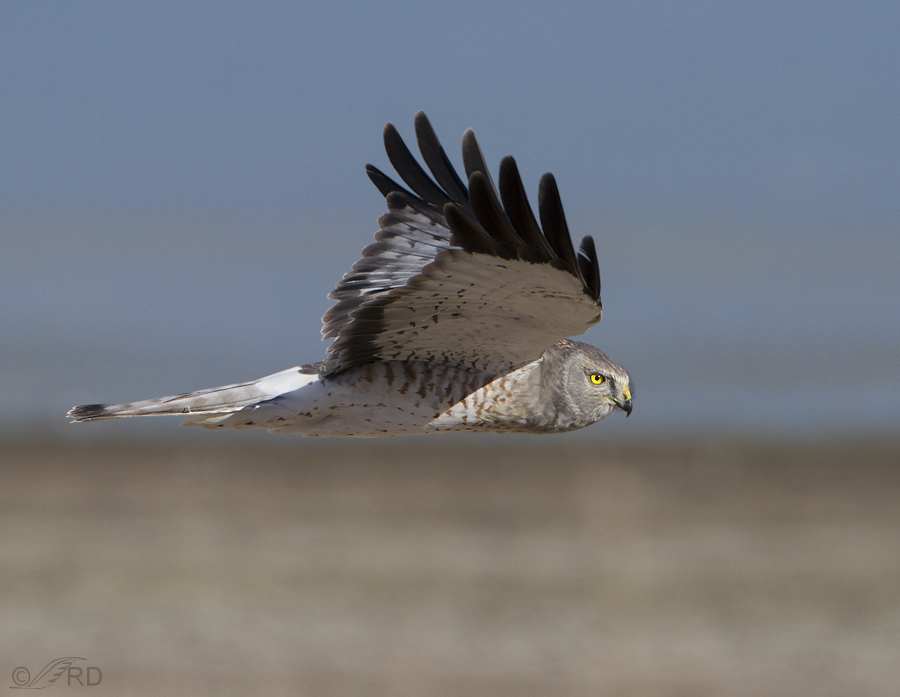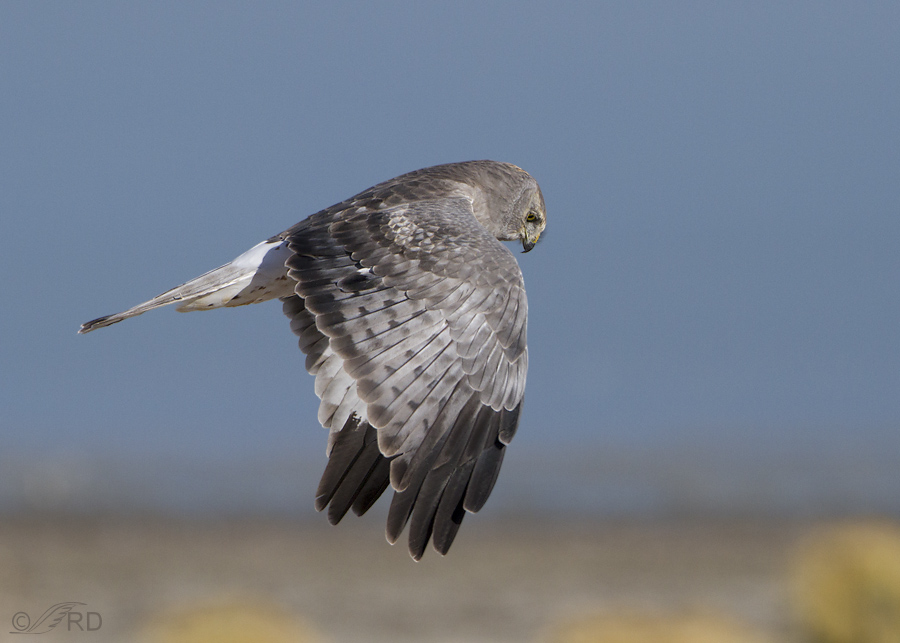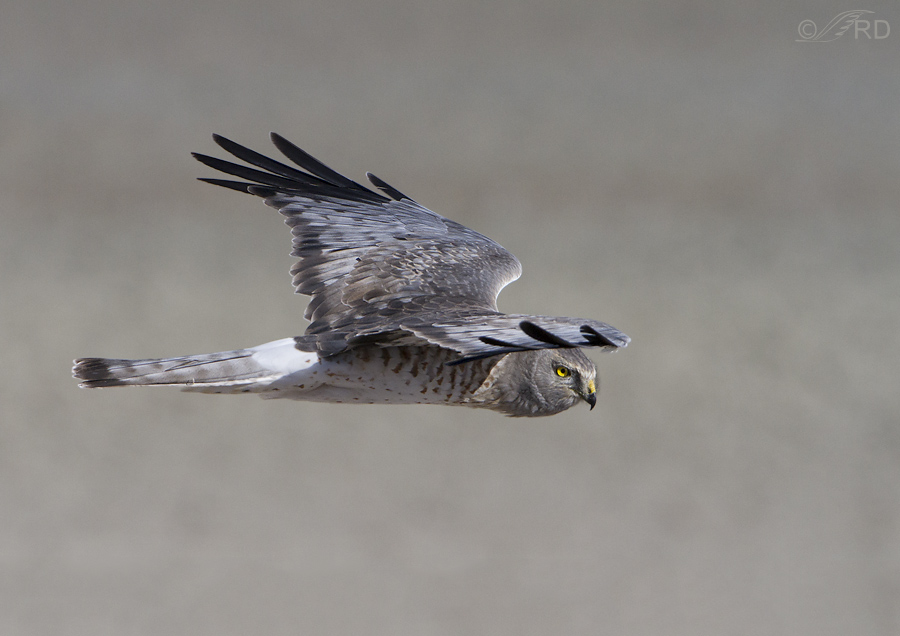Normally I avoid doing back to back posts on the same species but I went out shooting immediately after I published that last post and surprisingly it turned out to be a heckuva harrier morning. I’ve mentioned before that I usually have my best luck with harriers in the middle of winter, but yesterday I found two cooperative birds.

1/1600, f/6.3, ISO 500, 500 f/4, 1.4 tc, natural light, not baited, set up or called in
This beauty was hunkered down for a break from hunting and let me get surprisingly close. It was early morning, the light was warm, and the bird posed for me for a long time. I chose to post this almost direct look from the hawk for a reason – because out of all those images, this one shows the unique harrier facial disc best.
A facial disc is a concave arrangement of feathers on the face of some birds (most notably owls) that forms a circular parabaloid that collects sound waves and redirects them toward the ears. In harriers the disc is less prominent than in owls, but larger in relative size because it extends to the neck, so it is commonly referred to as a facial ruff, rather than a disc. The large ear openings of harriers are buried in the feathers of the head and can’t be seen. The angle of the disc or ruff feathers can be adjusted to alter the focal length of the sound waves they’re collecting, which allows the bird to “focus” at different distances – a neat trick when attempting to locate small prey in heavy vegetation. I’ve often seen harriers dive on prey when it’s buried in brush and watched the bird cock its head back and forth as it tries to hone in on the exact location of the prey from the rustling sounds they often make.
Most hawks normally hunt by sight alone – the arsenal of harriers is double that. This also explains why the hunting style of harriers is so distinctive from other hawks – harriers hunt very close to the ground to make their hearing more effective while other hawk species tend to hunt from higher elevations.

1/2000, f/7.1, ISO 500, 500 f/4, natural light, not baited, set up or called in
Finally, after almost 15 minutes of posing for me, the harrier took off. I wasn’t able to compose this shot as I would have preferred but I like the take-off posture and the good look at the eye.

1/3200, f/6.3, ISO 500, 500 f/4, natural light, not baited, set up or called in
Later in the morning I spotted this male harrier (males are often called “gray ghosts”, for their color and elusiveness) hunting along the road. For a variety of reasons it was always even with me or slightly past me when I got a shot that I liked but when I would get a slight look back from the bird I thought it made the image work pretty well. The upper background is the Great Salt Lake with mud and sand flats at bottom.

1/4000, f/6.3, ISO 500, 500 f/4, natural light, not baited, set up or called in
When harriers hunt they’re nearly always looking down (watching and listening), which makes it difficult to get a good look at the eye. But since this head position while hunting is typical for them I’ll often keep shots like that as long as the eye is distinct. If this had been an adult female with the very dark eye I’d have trashed the shot if I didn’t have a catch light.

1/4000, f/6.3, ISO 500, 500 f/4, natural light, not baited, set up or called in
An image like this sometimes throws our brains for a loop. We’re used to seeing blue sky backgrounds up top, a horizon line, then darker elements at bottom, but here those visual cues are reversed because there’s shallow water pools on the mud flats. In this shot the blue below is water, not sky and the darker background above is mud flats.

1/4000, f/6.3, ISO 500, 500 f/4, natural light, not baited, set up or called in
Even when the bird is this far in front of my position I’ll often still like the shot if it turns its head this much to look back at me. I do wish the right wing were lifted a bit more though.
Yep, yesterday was a harrier kind of day. As Mia and I often say to each other, “you just never know what we’ll see on the island”. Not that seeing harriers out there is at all unusual – but getting close to them this time of year certainly is.
Ron


What time in the morning do you usually see these harriers?
Hi Ron
So glad I stumbled upon your website and blog. A definite add to my daily reads. You’ve got some great images and even more impressive notes on bird behaviors. Very inspiring and helpful content. Thanks for sharing.
Ken
Thank you Ken. Sorry I’m late in moderating and commenting on your comment. I’ve been on a camping/photo trip with no internet access.
Just magnificent shots of an equally magnificent raptor… And as always, such wonderfully enlightening and educational information! THANKS! It’s great to learn about these guys through your words and amazing images. Fascinating.
Thank you Christina. I’m delighted to hear that you appreciate the “educational information” as much as you do the images.
Elephant’s Child, Tana and Christian – thanks so much for the kind words.
Tremendously beautiful birds there Ron, love the colours. You certainly had ‘the light’ on these ones!
Yes, I love tne last shot! And also the pics of both male and female. Thank you for shots of these favorite birds.
Beautiful as always. I really don’t mind which birds you post but the raptors and owls are particular favourites. Thank you.
The flatness of the head ,the thick neck give this bird an almost mammal like apperance. Small monkey head.
I will never see harrier’s the same way again . I always saw them leaving me.
Thanks for it all and more to come…
Eldridge, no question – my usual view of them is also from behind. The other frustrating thing about them is that as I approach them they nearly always fly to a position that puts them between me and the sun. Not a good thing for the photographer!
Once again, your images take my breath away. I’ve only ever seen (and photographed from such a distance the the shot is more landscape than bird)females or juveniles. I’ve never seen a male but I hope for that elusive encounter almost daily. I live in the San Francisco East Bay Area and see and photograph lots of Red-tailed and Red-shouldered hawks, and lots of White-tailed (aka Black-shouldered) Kites. I love them, but can’t wait for the day I get some acceptable (by my standards–certainly trash by yours)harrier shots.
Someday, I want to visit your Antelope Island.
Thank you again.
Thanks so much Sharon. I wish you luck with your harrier quest. I feel the same way about kites, of any species. I’ve never even seen one.